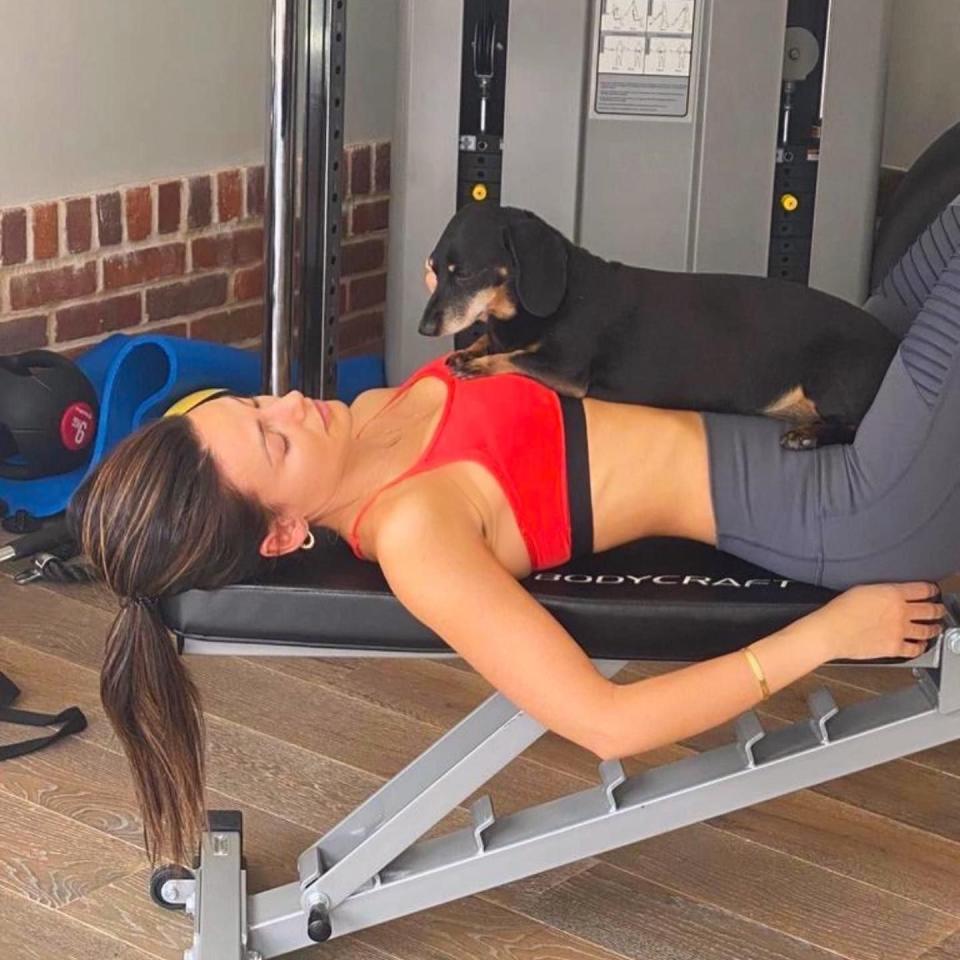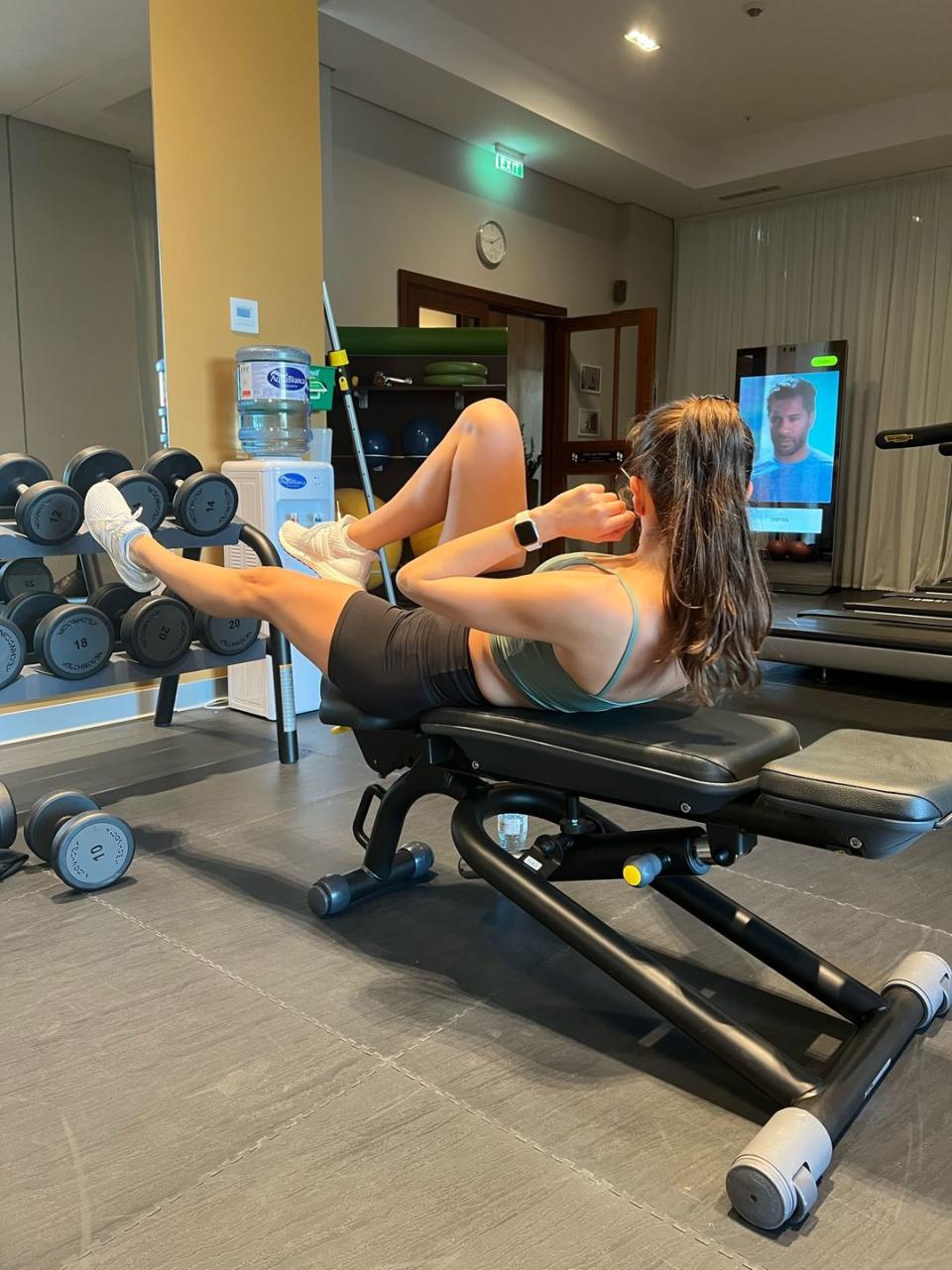'I followed Michelle Keegan's exercise routine for two weeks, here's everything I learnt'

From the cobbles of Corrie to playing fiery Erin in Brassic, Michelle Keegan is every bit the icon, having enchanted us on and off screen for decades.
Her skincare routine gets daily hits on Google, as fans desperately seek the secret to her glowing skin, and so too does her exercise routine, with fitness enthusiasts keen to get clear on how she builds strength to sustain a career that’s quite physically demanding.
We know the two-time Women’s Health cover star and Going for Goal podcast guest makes sure to prioritise her health, but she remains fairly private where the details of her workouts are concerned – the odd weight training session captured for Instagram notwithstanding. However, with all the digging I’ve done over the years, I’ve finally managed to form a reasonably solid interpretation of Keegan's exercise roster, which I’ve since given a go myself.
My incentive was two-fold: to ascertain how Mich sustains her strong physique—not for aesthetics sake (we are all unique and no two of us will ever look the same, after all), but to identify any particular workout habits of hers that might help me increase my strength.
And, secondly, to pinpoint what she does that gives her so much energy; if she’s not filming, she’s travelling, designing her own fashion line or attending red carpet events. Here’s what I found out.
Michelle Keegan’s workout routine
As I’ve mentioned, Mich hasn’t shared too much on her exercise routine in the past, but these are the principles she’s previously mentioned that helped me plan my two-week routine.
1.She doesn't enjoy cardio

Speaking to Women's Health, Michelle said she doesn't enjoy cardio, so she sticks to a combo of weight training and Pilates. ‘I don't enjoy cardio. It’s horrendous,' she said. 'Ugh, no, cardio has never been for me – I was always the girl that came last in sports day. I don't mind doing weights, I normally do half an hour of weights if I can and then half an hour of Pilates after that. Or walking, I love walking when the weather is nice. I’ll put a podcast on and take my dogs for a walk.’
2. She prefers to train in the morning
‘If I work out in the morning, it sort of sets me up for the rest of the day and I feel like I've got more of a spring in my step. I think you have to have a healthy relationship with [fitness] and not put pressure on yourself. If you put too much pressure on yourself to stick to a routine or a regime, I think that's when people fail,' she told us.
3. But she doesn't force herself if life gets in the way
’I'm not one of those people who sets their alarm at six to get up to get to the gym,’ Michelle told WH. 'If I’ve got work in the morning, I won't force myself, it's not something that I punish myself with, you know? I was so busy last week, I think I did a Pilates class once that whole week and I was fine about it.’
4. She uses workout splits to plan her weight training sessions
When structuring her strength training, Michelle adheres to a workout split: dedicating each day to a different muscle group. She told Cosmopolitan that one day she’ll focus on arms, the next on legs. As for the exact exercises she does, she previously shared this video on IG, showing her doing front-racked dumbbell squats, seated cable rows and bicycle crunches.
She’s also shared a few snaps on her IG Stories surrounded by barbells, kettlebells and dumbbells, after finishing training with them.

5. She enjoys cycling

When the unpredictable British weather permits, Mich likes to get out on her bike - a hobby she found during lockdown. 'I got into cycling, and I’ve never been into cycling in my life,' she told us. 'I didn’t even know what cleats were. I really got into it, and I really, really enjoyed it.
'So hopefully, when it gets a bit warmer, I’m going to start cycling again…sometimes I used to do it on my own [without Mark] and do 14 miles.'
Disclaimer: one thing Mich hasn’t divulged is exactly how often she works out per week. For the purpose of this article, I did three workouts and one cycle per week, with the thinking that Mich’s busy lifestyle probably doesn’t permit her much more.
Weekly routine:
Monday: 20-minute weighted upper-body workout + 20-minute Pilates YouTube workout
Tuesday: Rest
Wednesday: 20-minute weighted lower-body workout + 20-minute Pilates YouTube workout
Thursday: Rest
Friday: 20-minute weighted core workout + 20-minute Pilates YouTube workout
Saturday: Rest
Sunday: 40-min outdoor cycle
My experience
1.Training is easier in the morning

Like Mich, I much prefer morning to evening workouts. My muscles felt less tired from lugging a laptop around during the day, and my brain was generally more energised from having just recharged overnight. I also found it easier to get going, while my motivation often wanes after a day of work. All of this worked in favour of me getting up and onto my mat.
Gede Foster, Head of Fitness at FIIT says there are pros and cons to exercising in the morning vs the evening. 'Getting it done in the AM can boost cognitive function, help with better decision-making throughout the day and increase focus and productivity. On the flip side, your body hasn’t had much time to warm-up and move, so warming up is key.
'Meanwhile, trying to psych yourself up for a session at the end of your day can feel like a slog. Intense exercise could also raise your cortisol (the stress hormone) and adrenaline levels which could affect your ability to wind down and get a decent night's sleep. If you prefer a late night training session, make sure you do a 10-15 minute cool down to get your heart rate back to a stable level.'
2. Pilates felt harder after weights
Before now, I'd never done weights and Pilates consecutively. I presumed it would be slightly harder since they both use up your energy reserves, but I was more tired than expected, and many studies on the impact of doing two exercise modalities back to back show that the second session is affected.
When researchers in The Journal of Strength and Conditioning Research compared three workout protocols—strength training alone, running followed by strength, and cycling followed by strength—they found that running or cycling before a strength workout limited the number of weight lifting reps participants could perform compared to strength training without hitting a treadmill or exercise bike beforehand.
Similarly, another study found that muscle power decreased when lifting weights after running on a treadmill, while heart rate and the rate of perceived exertion, or how hard the workout felt, increased. It's all about how tired your muscles are.
'Trying to do a combo of strength sessions can be challenging because you have just demanded a lot from your nervous system meaning you are fatigued,' Foster tells us. 'You’re then asking your body to work with control and precision (two key Pilates principles).'
3. Workout splits really work
I've dabbled in workout splits before but never committed, and after just two weeks, I can confidently say that sticking to a split structure meant my muscles were considerably less tired each time I came to train. For example, I had three days between my leg strength training session and my cycle, so once each one came around, my legs had had three whole days to recover and were raring to go.
Foster is a big fan: 'Following workout splits allows you to train more frequently without overstressing the body, while giving adequate time for muscle groups to repair and recover.'
4. Cycling outdoors is much more enjoyable
I'm no stranger to the occasional spin class, but I wouldn't say I loved them. Nor do I particularly enjoy doing my own cycle at the gym. But Mich was right when she said taking your bike outdoors is a different ball game. There are probably a few factors at play here: having the outdoors to take in besides me just staring at the clock, people-watching to distract me, and the benefits of sun exposure (a scientifically proven mood-booster).
What's more, a previous study showed that just five minutes of outdoor exercise can improve your mental health. The research found that compared with exercising indoors, exercising in natural environments was associated with greater feelings of revitalisation, increased energy, and positive engagement. It was also shown to decrease tension, confusion, anger, and depression.
Read now: How to practise self-compassion and become more confident
More fitness stories:
What is Pilates? 34 exercises, benefits + 15 best online classes
Weight training for beginners: Benefits, tips, lingo + workouts
20 best HIIT workouts for all levels, from 5 to 45 minutes long
Cut through the noise and get practical, expert advice, home workouts, easy nutrition and more direct to your inbox. Sign up to the WOMEN'S HEALTH NEWSLETTER
You Might Also Like


